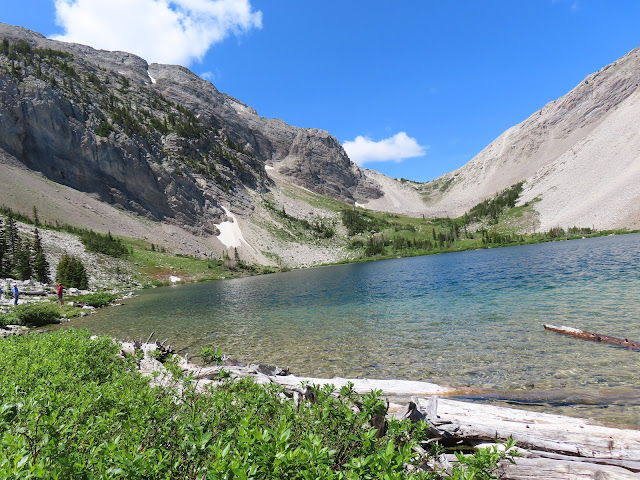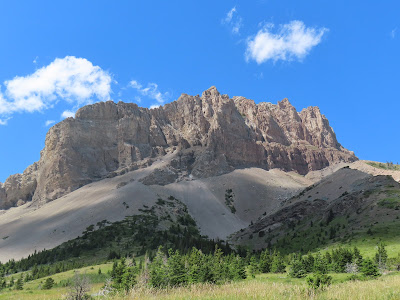 |
| The Des Lacs Wildlife Refuge in Kenmare, ND |
 |
| The Peace Garden north of Bottineau, ND reminded me of Versailles |
 |
| The Peace Garden featured an unusual display of cacti |
 |
| A trip highlight was St. John's University in Minnesota with its fantastic architecture |
The highlight of our recent trips were the tourist stops in North Dakota as we traveled to visit grandkids in Minneapolis.
We had exceptionally good and scenic experiences at the International Peace Garden on the North Dakota-Manitoba border, the adjacent Turtle Mountains State Recreation Area, the town of Kenmare, a picturesque and out of the way town on gorgeous Des Lac Wildlife Refuge, and Rugby, the geographical center of North America.
Unfortunately Canadian fires' smoke fouled the air and affected visibility.
Since I attend the University of North Dakota I had always wanted to see the Peace Garden and Turtle Mountains, which rise about 800 feet above the treeless plain around them. I was surprised by the lush vegetation and varieties of trees in this pocket range.
The Peace Garden was established between Manitoba and North Dakota in the 1930s and is a symbol of friendship and cooperation between the US and Canada.
The garden is open entry and you can wander into Manitoba on trails that continue from North Dakota.
The garden itself is reminiscent of the layout of the Versailles gardens in France and is beautifully planted.
 |
| Katie at summit of hiking trail at Black Sands State Park on Hauser Lake |
Black Sands State Park/BLM White Sands Campground
This was a quick trip as part of Katie's quest to get all the Montana state parks. This is a short distance away on the banks of the Missouri, reached from Hauser Lake.
The highlight of this trip was a short hike from a beachfront campground to a high point on a nice trail with great views of the Hauser impoundment. The campground was wall to wall hard-sided campers, but still pleasant.
We followed with an extremely steep hike to the ridge above the White Sands campground adjacent to the Black Sands State Park. The area was virtually empty.
We dealt with high heat and some wildfire smoke.
 |
| Katie on trail off Looking Glass Pass in Glacier Park with Two Med in background |
Two Med off the grid at Looking Glass Pass
We had a pleasant group hike on both sides of Looking Glass Pass in the Two Med area, going to the former BIA lookout site atop the Two Med Ridge on the Blackfeet Reservation, and then walking an old, rutted road on the other side into Glacier Park through a barbed wire fence to a spot above an unnamed lake at the foot of Spot Mountain.
 |
| Along the Teton River Canyon on Geology Tour |
Front Geology tour
Nicely lead by the Old Trail Museum, with a ridge walk at the Nature Conservancy's Pine Butte Swamp, usually off limits to the public.
I hadn't realized there was an A.B. Guthrie Trail that offered incredible views of Ear Mountain.
The trip took us to many places I had already seen, but it was well curated.
 |
| We crossed Pilgrim Creek several times on our hike |
 |
| Crossing Belt Creek to reach Pilgrim Creek |
Pilgrim Creek in Little Belts
Very scenic hike not far from where the Sluice Boxes State Park hike ends at the Logging Creek Bridge.
It had been years since I had hiked deeply into this area, once included in a Montana Omnibus Wilderness Bill that was pocket vetoed by President Reagan.
The trailhead is reached on the Logging Creek Road opposite the Raynesford turnoff on US 89. It is a 7 miles ride on a narrow and tight rocky road.
The trail passes below high cliffs before it drops to Belt Creek, which must be crossed to access Pilgrim Creek, that flows through a very narrow and heavily forested valley. Pilgrim Creek is unusual for its solid limestone bottom.
Outside hunting season it is rarely used.
I've backpacked the length of creek to its Divide Road source.
We went in three miles and turned around on a scorching, hot day.
Very isolated and quiet trail.
Pioneer Ridge loop
I took first-timer Mike Smith on this 5-mile, sometimes off-trail loop that I often do when I don't have much time.
We follow the trail near the Neihart Ranger Station for a couple of miles to the ridge line, about a 2,000 feet gain. We then find remnants of what must have been a trail, but which the Forest Service abandoned to a rocky outcropping high point and then steeply down to an open, grassy elk meadow that circles back to our trailhead.





















































